Understanding Different Financial Reports and Techniques
27 Pages8038 Words26 Views
Added on 2020-02-03
Understanding Different Financial Reports and Techniques
Added on 2020-02-03
ShareRelated Documents
Managing Financial
Principles and
Techniques
Principles and
Techniques
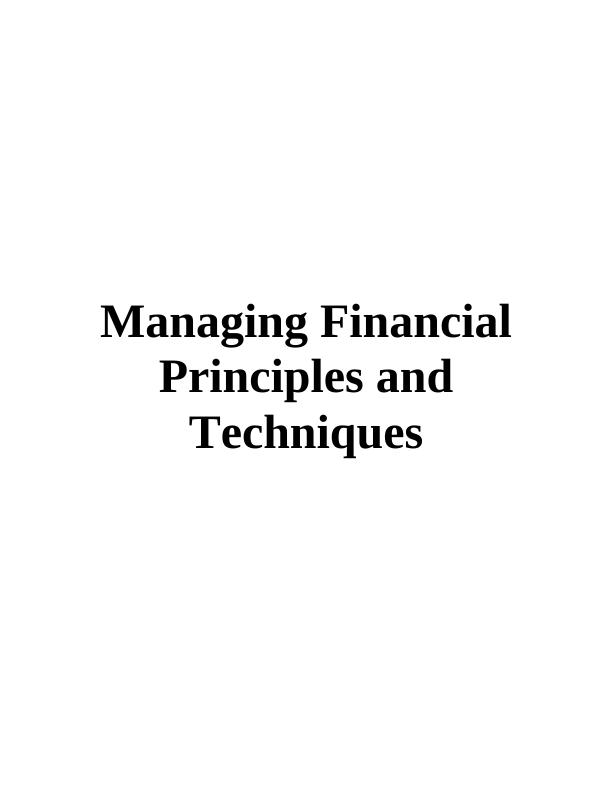
Table of Contents
INTRODUCTION...........................................................................................................................3
TASK 1............................................................................................................................................3
1.1 Importance of costs in the pricing strategy of an organization:.............................................3
1.2 Design a costing system for use within an organization........................................................4
1.3 Improvements to the costing and pricing systems used by an organization..........................5
TASK 2............................................................................................................................................6
2.1 Forecasting Techniques in an Organization to make Cost and Revenue Decisions..............6
2.2 Sources of Finance.................................................................................................................8
TASK 3..........................................................................................................................................10
3.1 select appropriate budgetary targets for an organization: ...................................................10
3.2 Participate in the creation of a master budget for an organization......................................12
3.3 compare actual expenditure and income to the master budget of an organization..............13
3.4 evaluate budgetary monitoring processes in an organization..............................................13
TASK 4..........................................................................................................................................14
4.1 recommend processes that could manage cost reduction in an organization.......................14
4.2 Evaluate the potential for the use of activity-based costing:...............................................15
TASK 5..........................................................................................................................................16
5.1 Financial appraisal methods to analyze investment projects in public and private sector...16
5.2 Strategic investment decision for organization through using financial information..........18
5.3 Audit appraisal.....................................................................................................................18
TASK 6..........................................................................................................................................19
6.1 Financial statements to assess financial viability of Sainsbury...........................................19
6.2 Financial ratios to improve quality of financial information for organization's effectiveness
....................................................................................................................................................21
6.3 Recommendation on strategic portfolio of organization.....................................................23
CONCLUSION..............................................................................................................................23
REFERENCE.................................................................................................................................24
INTRODUCTION...........................................................................................................................3
TASK 1............................................................................................................................................3
1.1 Importance of costs in the pricing strategy of an organization:.............................................3
1.2 Design a costing system for use within an organization........................................................4
1.3 Improvements to the costing and pricing systems used by an organization..........................5
TASK 2............................................................................................................................................6
2.1 Forecasting Techniques in an Organization to make Cost and Revenue Decisions..............6
2.2 Sources of Finance.................................................................................................................8
TASK 3..........................................................................................................................................10
3.1 select appropriate budgetary targets for an organization: ...................................................10
3.2 Participate in the creation of a master budget for an organization......................................12
3.3 compare actual expenditure and income to the master budget of an organization..............13
3.4 evaluate budgetary monitoring processes in an organization..............................................13
TASK 4..........................................................................................................................................14
4.1 recommend processes that could manage cost reduction in an organization.......................14
4.2 Evaluate the potential for the use of activity-based costing:...............................................15
TASK 5..........................................................................................................................................16
5.1 Financial appraisal methods to analyze investment projects in public and private sector...16
5.2 Strategic investment decision for organization through using financial information..........18
5.3 Audit appraisal.....................................................................................................................18
TASK 6..........................................................................................................................................19
6.1 Financial statements to assess financial viability of Sainsbury...........................................19
6.2 Financial ratios to improve quality of financial information for organization's effectiveness
....................................................................................................................................................21
6.3 Recommendation on strategic portfolio of organization.....................................................23
CONCLUSION..............................................................................................................................23
REFERENCE.................................................................................................................................24
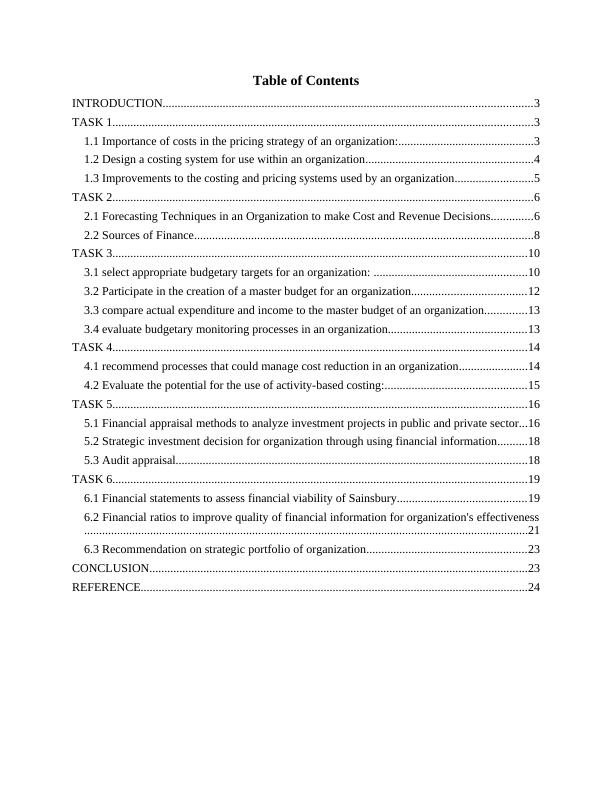
INTRODUCTION
Financial performance of any organization represents entity's profitability and earning
power to formulate and implement strategies. It is related with firm's effectiveness and enhancing
its efficiencies at high level. The present report is based on understanding different financial
reports and techniques to analyze economic structure as well improving quality services for
further implementation of Sainsbury. It is public retail sector large scale supermarket chain of
UK that provides groceries and food items. However, pricing strategies and costing systems are
to be described. Including this, different forecasting and decision making tools for implementing
further business operation can be determined. Moreover, budgetary planning system and costing
methods for strategic planning procedure and making decisions regarding business activities can
be recognized. In addition to this, various financial appraisal methods and technqiues for
adequate investment is to expressed through this assignment.
TASK 1
1.1 Importance of costs in the pricing strategy of an organisation:
Pricing Decisions: Ho much company spend to produce a unit of product is valuable
when figure out the sales price. If Sainsbury Company want to compete on price, than they have
to keep price of product as low as possible. But if product is sold at cost less then manufacturing
cost then they cant go for long in market. So while selling it is important to keep price not to
high and not too low and at this point of time different cost concept is used to fix adequate price
(Bakand, Hayes and Dechsakulthorn, 2012).
Preparing Financial Reporting: Adherence to more specific cost technique are require
under General acceptance Accounting Principles. For external financial reports purpose and
GAAP require all manufacturing cost that incurred in manufacturing goods. Costing system that
behave cost in this manner are called absorption technique, full cost costing, traditional system.
Helpful in Budgeting: Cost concept also help in budgeting and budgetary control. There
are various tools used in budgetary control. Fixed, Variable and Zero base budget (Bartram,
Brown and Waller, 2016). With this budgeting system financial requirement can be fulfilled
within limited resources and maximum utilisation of financial sources can be made possible and
from it, pricing of product that is ready for sale in market is optimised.
Financial performance of any organization represents entity's profitability and earning
power to formulate and implement strategies. It is related with firm's effectiveness and enhancing
its efficiencies at high level. The present report is based on understanding different financial
reports and techniques to analyze economic structure as well improving quality services for
further implementation of Sainsbury. It is public retail sector large scale supermarket chain of
UK that provides groceries and food items. However, pricing strategies and costing systems are
to be described. Including this, different forecasting and decision making tools for implementing
further business operation can be determined. Moreover, budgetary planning system and costing
methods for strategic planning procedure and making decisions regarding business activities can
be recognized. In addition to this, various financial appraisal methods and technqiues for
adequate investment is to expressed through this assignment.
TASK 1
1.1 Importance of costs in the pricing strategy of an organisation:
Pricing Decisions: Ho much company spend to produce a unit of product is valuable
when figure out the sales price. If Sainsbury Company want to compete on price, than they have
to keep price of product as low as possible. But if product is sold at cost less then manufacturing
cost then they cant go for long in market. So while selling it is important to keep price not to
high and not too low and at this point of time different cost concept is used to fix adequate price
(Bakand, Hayes and Dechsakulthorn, 2012).
Preparing Financial Reporting: Adherence to more specific cost technique are require
under General acceptance Accounting Principles. For external financial reports purpose and
GAAP require all manufacturing cost that incurred in manufacturing goods. Costing system that
behave cost in this manner are called absorption technique, full cost costing, traditional system.
Helpful in Budgeting: Cost concept also help in budgeting and budgetary control. There
are various tools used in budgetary control. Fixed, Variable and Zero base budget (Bartram,
Brown and Waller, 2016). With this budgeting system financial requirement can be fulfilled
within limited resources and maximum utilisation of financial sources can be made possible and
from it, pricing of product that is ready for sale in market is optimised.
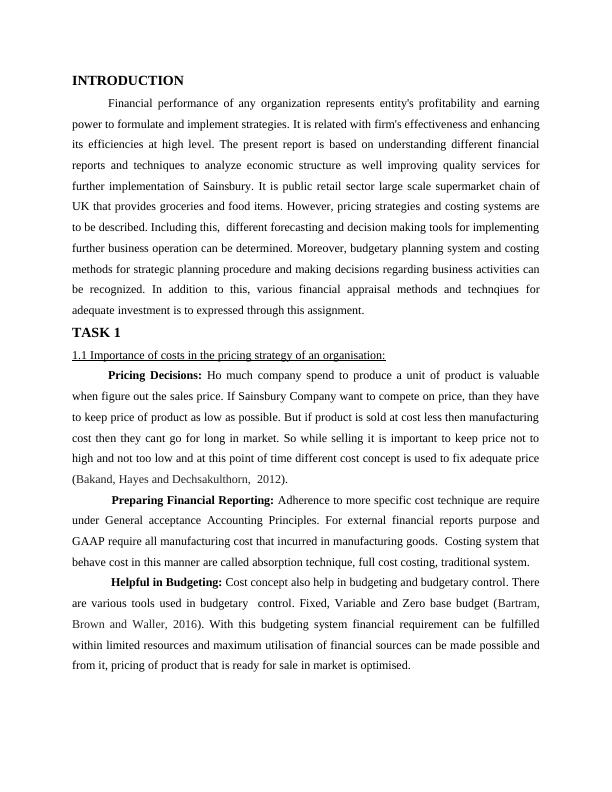
Many business decision requires a firm knowledge of several cost concept. Different
type of cost having different characteristics. Consequentially when reviewing a business case to
determine which way to choose it is important to understand following cost concept to choose.
Fixed, Variable and Mixed cost: A fixed cost such as rent, does not changes in with level
of activity. In opposite to it variable cost such as direct material is changeable with level of
activity. Those few cost which changes somewhat with activity are included in mixed cost
(Battiston and et.al., 2016). It is important to understand the differences, since the decision to
alteration in level of activity may or may not alter cost. For ex, shutting down a facility may not
terminate associated building lease payment which are fixed since duration it was leased.
Marginal cost: It is total of variable cost i.e., prime cost plus variable overhead. It is bsed
on difference between fixed and variable cost. Fixed cost are ignored variable cost are
considered for determining cost of production, work in progress and value of finished goods
(Caspin and et.al., 2013).
Out Of pocket Cost: It involves payment to outsiders such as increase in cash expenditure as
proportionate to cost of depreciation, which does not concluded any cash expenditure. Such cost
are used in price fixation at time of recession or when make or buy alternative option of decision
is made.
1.2 Design a costing system for use within an organisation
A costing system is designed to monitor the cost incurred by the business. Whole business
system is connected to sat of forms, process, control and reports that are designed to aggregate
and report to management revenues, cost and profitability. Areas included in can be any part of
the company, including Customers, Department, Facilities, Process, Product and services,
Research and development, Sales etc.
There are two main type of costing system. A business can circulate information based on either
one of these or mixed that is called hydride system that mix match system to meets its need.
Job costing System: Material, labour, and overhead are compiled from individual unit or job.
This approach best for unique purpose such as custom design machine or consulting projects. It
is highly detailed and labour intensive (Cheng, Ioannou and Serafeim, 2014).
Process costing System: Material, Labour and overhead are totalled for an entire production
process and then are allocated to individual production unit, processing of milk, Petroleum
type of cost having different characteristics. Consequentially when reviewing a business case to
determine which way to choose it is important to understand following cost concept to choose.
Fixed, Variable and Mixed cost: A fixed cost such as rent, does not changes in with level
of activity. In opposite to it variable cost such as direct material is changeable with level of
activity. Those few cost which changes somewhat with activity are included in mixed cost
(Battiston and et.al., 2016). It is important to understand the differences, since the decision to
alteration in level of activity may or may not alter cost. For ex, shutting down a facility may not
terminate associated building lease payment which are fixed since duration it was leased.
Marginal cost: It is total of variable cost i.e., prime cost plus variable overhead. It is bsed
on difference between fixed and variable cost. Fixed cost are ignored variable cost are
considered for determining cost of production, work in progress and value of finished goods
(Caspin and et.al., 2013).
Out Of pocket Cost: It involves payment to outsiders such as increase in cash expenditure as
proportionate to cost of depreciation, which does not concluded any cash expenditure. Such cost
are used in price fixation at time of recession or when make or buy alternative option of decision
is made.
1.2 Design a costing system for use within an organisation
A costing system is designed to monitor the cost incurred by the business. Whole business
system is connected to sat of forms, process, control and reports that are designed to aggregate
and report to management revenues, cost and profitability. Areas included in can be any part of
the company, including Customers, Department, Facilities, Process, Product and services,
Research and development, Sales etc.
There are two main type of costing system. A business can circulate information based on either
one of these or mixed that is called hydride system that mix match system to meets its need.
Job costing System: Material, labour, and overhead are compiled from individual unit or job.
This approach best for unique purpose such as custom design machine or consulting projects. It
is highly detailed and labour intensive (Cheng, Ioannou and Serafeim, 2014).
Process costing System: Material, Labour and overhead are totalled for an entire production
process and then are allocated to individual production unit, processing of milk, Petroleum
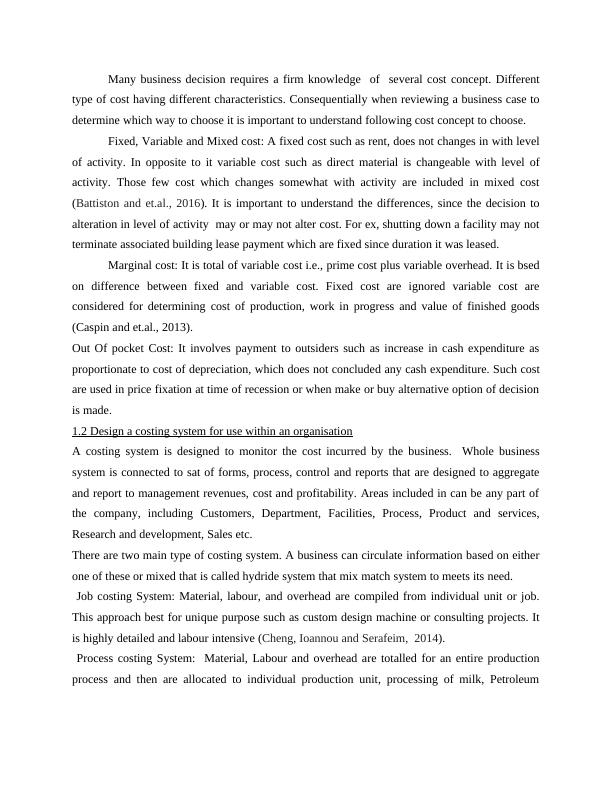
products, Cell phone manufacturing are part of process costing where production done at large
level. Cost accumulated is highly efficient and divided in no. of units per batch is possibly be
automated.
Differential Cost: Change in cost due to change in level of activity,pattern, technology,
process or method of production is known as differential cost. If any changes proposed or
happened in existing level or method of activity of production, the increase or decrease in
total cost because of decision is known as differential cost (Chhokar and et.al., 2013). If
changes increase in cost, it is called incremental cost and if there is decrease in cost
results from decrease in output the result is known as decremental cost.
Sunk Cost: Sunk cost is irrevocable cost and is caused by complete abandonment or
shutting down of plant of business. It is written down value of abandoned plant less its
salvage value. Such cost are historical cost which are incurred in past and are not relevant
for decision making and are not affected by increase or decrease of volume of output.
Thus expenditure which has taken place is irrecoverable in a situation is treated as sunk
cost. Such cost included depreciation of fixed assets (Clark, Gilbert and Ca, 2014).
Opportunity cost: It is maximum possibility alternatives earnings that might have been
earned if productivity capacity or service had been put to some alternative use. In simple
words it is advantage in measured term gone due to not using other alternatives that could
have generated more profit then current cost. For example, If owned building is proposed
to be used for projects then rent on building is considered to be an opportunity cost while
taken into consideration the evaluation of the profitability of projects. PASS
1.3 Improvements to the costing and pricing systems used by an organisation
Improvement in costing to good financial management: Ability to identify, interpret and present
cost as they are related to organisational economic flow of goods and services, both historical
and forward looking context, is necessary for an informed understanding of the organisational
driver of profit and value (Midrigan and Xu, 2014).
Material cost effectiveness: The designed, implementation, and continuous improvement of
costing method, improvement in data collection and system should reflect a balance between the
level. Cost accumulated is highly efficient and divided in no. of units per batch is possibly be
automated.
Differential Cost: Change in cost due to change in level of activity,pattern, technology,
process or method of production is known as differential cost. If any changes proposed or
happened in existing level or method of activity of production, the increase or decrease in
total cost because of decision is known as differential cost (Chhokar and et.al., 2013). If
changes increase in cost, it is called incremental cost and if there is decrease in cost
results from decrease in output the result is known as decremental cost.
Sunk Cost: Sunk cost is irrevocable cost and is caused by complete abandonment or
shutting down of plant of business. It is written down value of abandoned plant less its
salvage value. Such cost are historical cost which are incurred in past and are not relevant
for decision making and are not affected by increase or decrease of volume of output.
Thus expenditure which has taken place is irrecoverable in a situation is treated as sunk
cost. Such cost included depreciation of fixed assets (Clark, Gilbert and Ca, 2014).
Opportunity cost: It is maximum possibility alternatives earnings that might have been
earned if productivity capacity or service had been put to some alternative use. In simple
words it is advantage in measured term gone due to not using other alternatives that could
have generated more profit then current cost. For example, If owned building is proposed
to be used for projects then rent on building is considered to be an opportunity cost while
taken into consideration the evaluation of the profitability of projects. PASS
1.3 Improvements to the costing and pricing systems used by an organisation
Improvement in costing to good financial management: Ability to identify, interpret and present
cost as they are related to organisational economic flow of goods and services, both historical
and forward looking context, is necessary for an informed understanding of the organisational
driver of profit and value (Midrigan and Xu, 2014).
Material cost effectiveness: The designed, implementation, and continuous improvement of
costing method, improvement in data collection and system should reflect a balance between the
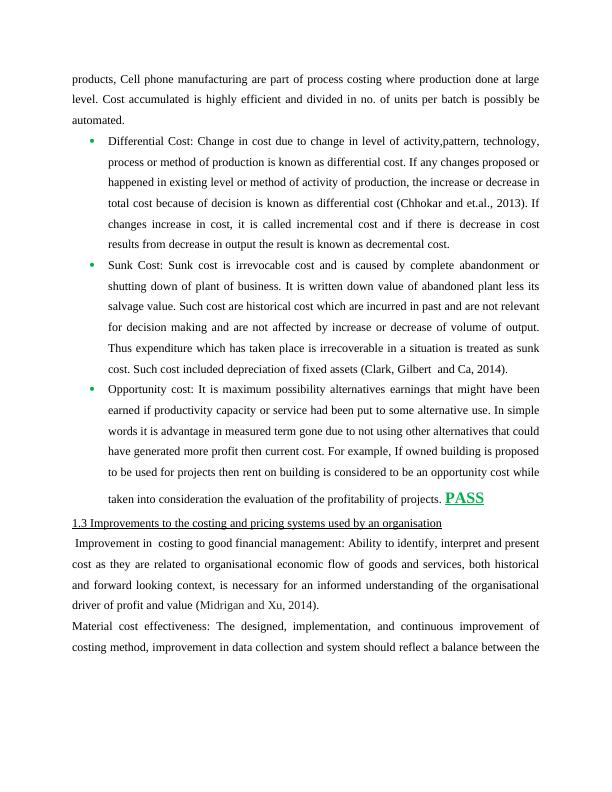
required level of accuracy and the cost of measurement (cost benefits tradesoff) depends on
competitive situation of the organisation.
Time and Consistency: Cost information should be collected and analysed in systematic manner
so as to ensure comparability over time, whether in routine information system, or for specific
application and or purpose (Park and Park, 2014).
Transparency and auditability: Definition and source of data, the operational and other non
financial data and method of calculating cost needs to be transparent to customers and recorded
and capable of review, risk analysis and assurance.
Replacement cost: It is cost at which there is purchase of assets or material exactly
replica that would have been replaced or re-evaluate. It is cost of replacement at current
market value.
Avoidable and unavoidable cost: Those cost which are avoided if particular product or
department with which they are directly related is discontinued. For ex, salary salary of
clerk belongs to department employed is eliminated if that department is discontinued.
Unavoidable cost is opposite to avoidable cost which is not been avoided even with
discontinuation of projects or department (Park and Park, 2014). For ex, Salary of factory
manger, factory rent etc.
TASK 2
2.1 Forecasting Techniques in an Organization to make Cost and Revenue Decisions
Forecasting means predicting about the future on the basis of past and present data and
the trends followed by the organisation.
Types of Forecasts :-
Economic Forecasts
Technological Forecasts
Demand Forecasts
Categories of Forecasting Methods :-
A. Qualitative v/s Quantitative Method – Qualitative Method is a technique based on
opinions, judgements, intuitions, emotions, or personal experiences, and also is subjective in
nature. Whereas, Quantitative Method of forecasting is based on mathematical(quantitative)
competitive situation of the organisation.
Time and Consistency: Cost information should be collected and analysed in systematic manner
so as to ensure comparability over time, whether in routine information system, or for specific
application and or purpose (Park and Park, 2014).
Transparency and auditability: Definition and source of data, the operational and other non
financial data and method of calculating cost needs to be transparent to customers and recorded
and capable of review, risk analysis and assurance.
Replacement cost: It is cost at which there is purchase of assets or material exactly
replica that would have been replaced or re-evaluate. It is cost of replacement at current
market value.
Avoidable and unavoidable cost: Those cost which are avoided if particular product or
department with which they are directly related is discontinued. For ex, salary salary of
clerk belongs to department employed is eliminated if that department is discontinued.
Unavoidable cost is opposite to avoidable cost which is not been avoided even with
discontinuation of projects or department (Park and Park, 2014). For ex, Salary of factory
manger, factory rent etc.
TASK 2
2.1 Forecasting Techniques in an Organization to make Cost and Revenue Decisions
Forecasting means predicting about the future on the basis of past and present data and
the trends followed by the organisation.
Types of Forecasts :-
Economic Forecasts
Technological Forecasts
Demand Forecasts
Categories of Forecasting Methods :-
A. Qualitative v/s Quantitative Method – Qualitative Method is a technique based on
opinions, judgements, intuitions, emotions, or personal experiences, and also is subjective in
nature. Whereas, Quantitative Method of forecasting is based on mathematical(quantitative)
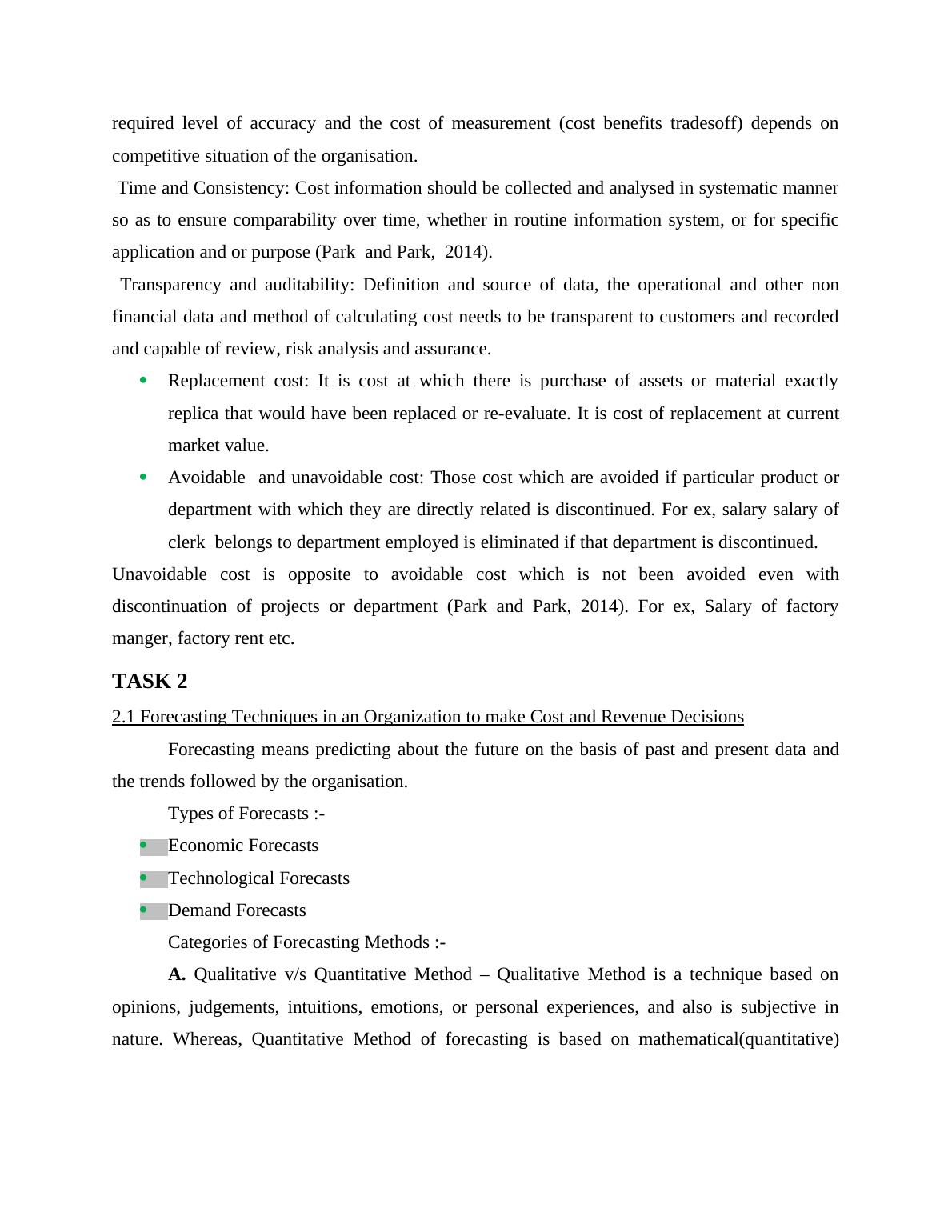
End of preview
Want to access all the pages? Upload your documents or become a member.
Related Documents
Managing Financial Principles and Techniques Essaylg...
|28
|9716
|47
Managing Financial Principles And Techniqueslg...
|24
|7571
|176
L7-DSML: Information Management and Strategic Decisionlg...
|51
|9741
|218
Financial Management Assignment | Costing Job And Process Costinglg...
|21
|5402
|215
Principles of Management Accounting PDFlg...
|23
|7767
|2468
Financial Management Principles: Costing, Forecasting, Budgeting and Investment Appraisallg...
|22
|5088
|383
